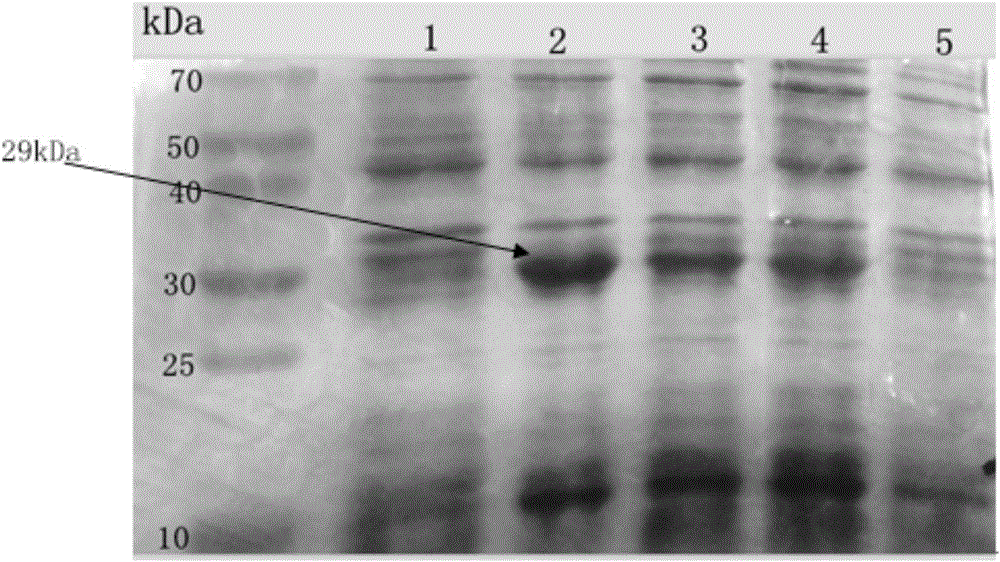PEDV S gene major antigen epitope serial connection recombination gene, and preparation method and application thereof
A main antigen epitope and recombinant gene technology, applied in biochemical equipment and methods, recombinant DNA technology, chemical instruments and methods, etc., can solve the problems of unstable expression, many variations in the S1 region of PEDVS protein, and poor monitoring by ELISA and assess the level of neutralizing antibodies in swine herds to achieve high-efficiency, stable expression and strong immunogenicity
- Summary
- Abstract
- Description
- Claims
- Application Information
AI Technical Summary
Problems solved by technology
Method used
Image
Examples
Embodiment 1
[0039] Example 1 Synthesis of target fragments
[0040] Using the S gene of the cell-adapted mutant GDGZ12 strain isolated in our laboratory as a template, three antigenic epitopes S1 (1368-1374aa), S2 (499-638aa) and S3 (697-771aa) were selected. Linked with flexible amino acid (GGTGTGGTGGTAGC) base sequence, with XhoI and BamHI at both ends of the target fragment, this part was synthesized by Jinweizhi Biotechnology Co., Ltd., and the concatenated S gene was named S123, with a total size of 708bp. The results of PCR identification of recombinant cloned plasmids are as follows: figure 1 shown.
Embodiment 2
[0041] Example 2 Construction and identification of expression vector pET-28a-S123
[0042] 1. The vector pet-28a is connected to the target fragment S123
[0043] The prokaryotic expression vector pET-28a was double digested, and the digest reaction was carried out in a water bath at 37°C, and the digest time was 4h to 5h or overnight. After double digestion, an agarose gel was performed to recover the digestion product. After recovery, the purified and recovered target gene S123 was connected to the expression vector pET-28a, and the connection system was shown in Table 1:
[0044] Table 1 Expression vector connection system
[0045]
[0046] 2. Identification of pET-28a-S123 double enzyme digestion
[0047] Recombinant plasmid Pet-28a-S123 adopts BamHI and XhoI double-enzyme digestion identification system respectively as shown in Table 2. The digestion reaction is carried out in a 37 ℃ water bath, and the digestion time is 4h ~ 5h or overnight digestion. After double...
Embodiment 3
[0050] Example 3 Expression of target gene in Escherichia coli
[0051] Pick a single colony on the kan plate that has been identified as positive bacteria BL21 (DE3), inoculate it in 3 ml of LB medium containing kan, and set up an empty vector control group at the same time. ). The next morning, the overnight cultured bacterial solution was inoculated into 3 mL of LB medium containing kan at a ratio of 1:100, and placed in a shaker at 37 °C for 150-200 r / min and cultured until the OD600 was about 0.6-0.8. IPTG was added to The final concentration was 1.0 mmol / mL, and expression was induced for 4-6 hours. Identification by SDS-PAGE electrophoresis. At the same time, an empty vector control and a zero induction control were established. The results of recombinant plasmid expression in BL21(DE3) are shown in the figure image 3 shown.
[0052] 1 Preparation of samples for expression products
[0053] Take the bacterial samples before and after induction and set up an empty...
PUM
 Login to View More
Login to View More Abstract
Description
Claims
Application Information
 Login to View More
Login to View More - R&D
- Intellectual Property
- Life Sciences
- Materials
- Tech Scout
- Unparalleled Data Quality
- Higher Quality Content
- 60% Fewer Hallucinations
Browse by: Latest US Patents, China's latest patents, Technical Efficacy Thesaurus, Application Domain, Technology Topic, Popular Technical Reports.
© 2025 PatSnap. All rights reserved.Legal|Privacy policy|Modern Slavery Act Transparency Statement|Sitemap|About US| Contact US: help@patsnap.com



